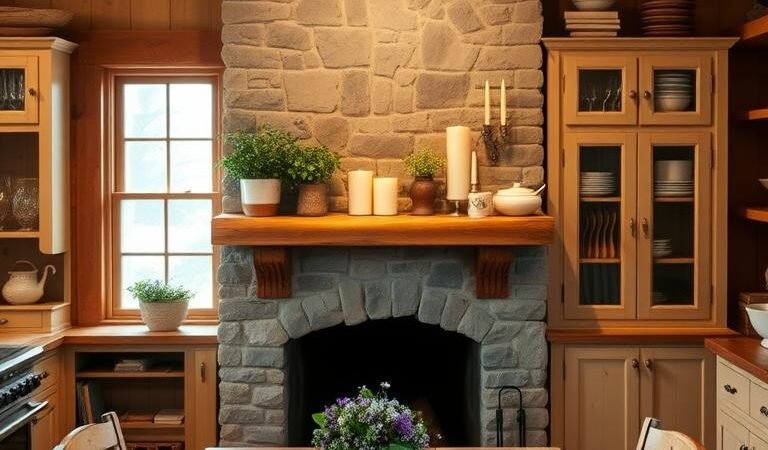Nothing says home like a space that blends timeless charm with everyday comfort. The heart of many homes, this style balances natural textures and cozy accents to create an inviting atmosphere. Think wide-plank floors, apron sinks, and open shelving—each detail adding character while keeping functionality in mind.
Sunlight streaming through linen curtains, the soft hum of a coffee maker, and the warmth of reclaimed wood—these are the touches that turn a room into a retreat. Whether you love the collected-over-time look or prefer clean-lined simplicity, there’s a way to make the design work for you. Explore how to blend modern farmhouse decor with personal flair.
Key Takeaways
- Farmhouse kitchens combine rustic appeal with modern practicality.
- Natural materials like wood and stone add warmth and texture.
- Apron sinks and open shelving are signature elements.
- Neutral palettes create a calming, versatile backdrop.
- Mixing vintage and contemporary pieces adds personality.
1. Embrace the Unfitted Kitchen Aesthetic
Step away from cookie-cutter designs with a space that tells your story. Unfitted layouts ditch built-in cabinets for standalone pieces—think antique tables as islands or glass-front hutches holding heirloom dishes. The result? A lived-in charm that feels authentic, not staged.
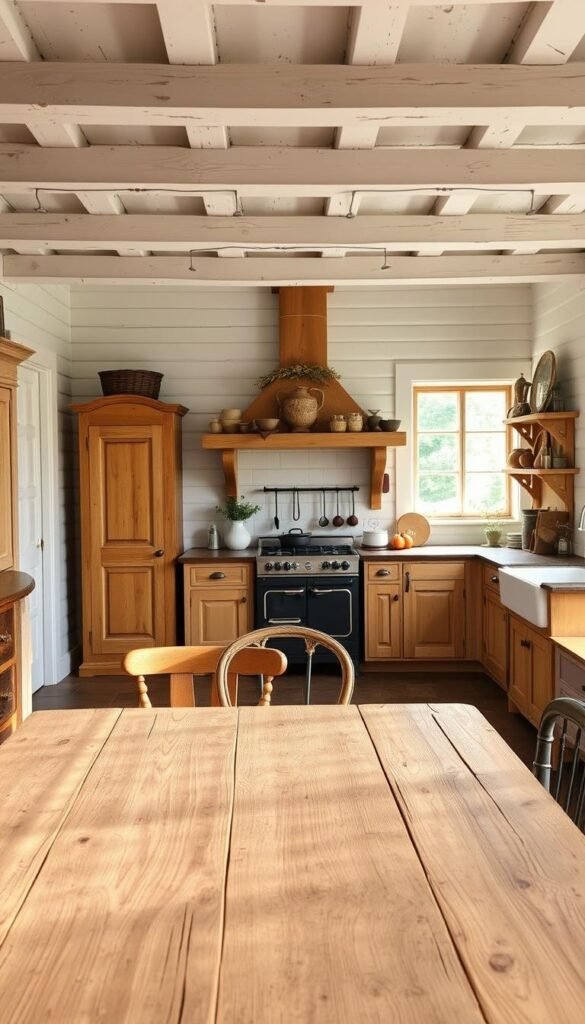
Freestanding Furniture for a Collected Look
Designer Rikki Snyder transformed a Hudson, NY home using a 19th-century table as a functional island. Flanked by mismatched stools, it anchors the room without rigid symmetry. Open shelving and a pine hutch keep essentials within reach while adding texture.
Benefits of freestanding furniture:
- Flexibility: Swap pieces seasonally or rearrange for gatherings.
- Character: Scratches and patina add instant history.
- Function: Baker’s racks double as herb-drying stations.
Vintage Appliances with Modern Functionality
Pair vintage finds like a Smeg fridge with rustic beams for contrast. Retro appliances offer today’s tech in yesterday’s packaging—think quiet dishwashers behind salvaged cabinet fronts.
| Freestanding Piece | Built-In Alternative | Why It Works |
|---|---|---|
| Antique table island | Custom cabinetry | Adds warmth and mobility |
| Wire baker’s rack | Wall-mounted shelves | Airy storage for pots or plants |
| Armoire pantry | Walk-in closet | Hides clutter with charm |
This farmhouse style thrives on imperfection. Let each piece—whether a flea-market find or a retro stove—speak for itself.
2. Highlight Wide-Plank Hardwood Floors
Few elements ground a room like the rich texture of hardwood beneath your feet. Wide-plank floors add instant country charm, their broad surfaces showcasing natural grain variations. Whether reclaimed or new, these floors anchor the design while inviting warmth.
Reclaimed vs. New Wood: Pros and Cons
Authentic reclaimed oak (¾” thick) boasts unmatched character—nail holes, saw marks, and subtle color shifts. Engineered alternatives offer stability but lack the same depth. Designer Christopher Horwood of Artichoke LTD enhances reclaimed planks with wire brushes, emphasizing their history.
| Feature | Reclaimed Wood | New Wood |
|---|---|---|
| Durability | High (dense old-growth timber) | Varies (check Janka hardness) |
| Eco-Friendliness | Sustainable (repurposed material) | Depends on sourcing |
| Cost | $$$ (premium for patina) | $–$$ (wider range) |
Encouraging Natural Wear for Character
Matte finishes deepen over time, hiding scuffs while enhancing patina. Artichoke LTD’s technique involves leaving ¼” gaps between planks for rustic authenticity. Ideal widths? 8–12″ for proportional scaling in country homes.
- Embrace imperfections: Let dents and scratches tell your floor’s story.
- Skip polyurethane: Oil-based finishes age gracefully.
- Mix widths: Combine 10″ and 12″ planks for organic variation.
These floors aren’t just surfaces—they’re layers of history woven into your daily life.
3. Maximize Small Spaces with Smart Storage
Smart storage solutions turn tight corners into functional treasures. In a small kitchen, every inch counts—think vertical racks and dual-purpose antiques. These choices blend practicality with collected-over-time charm.
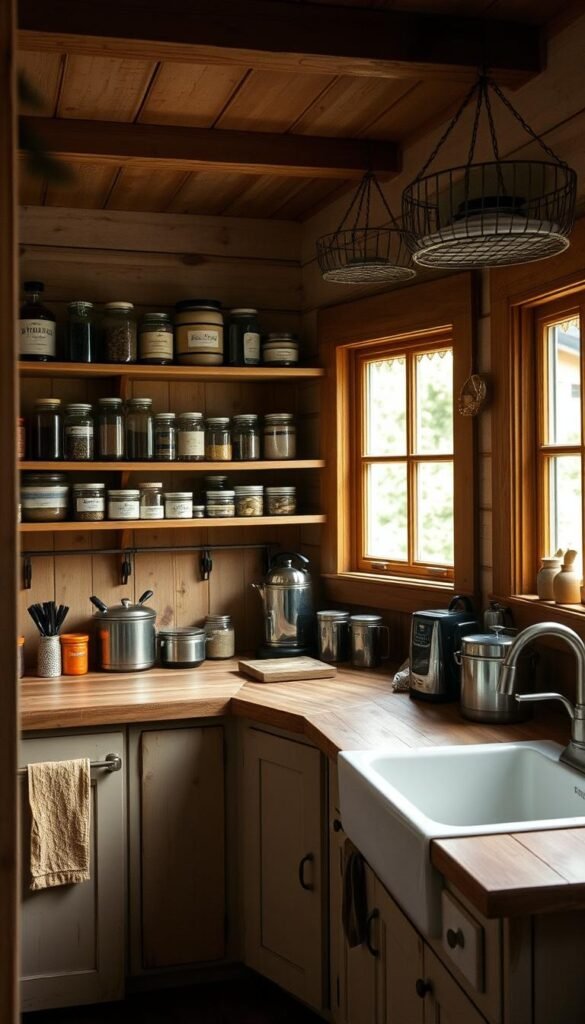
Wall-Mounted Plate Racks and Pot Hangers
Ditch bulky upper cabinets for wrought iron pot racks. They free up counter space while adding rustic flair. A Cape Cod cottage by Read McKendree pairs copper hangers with open shelving for a cohesive look.
- Vertical storage: Hang pots, utensils, or drying herbs.
- Plate racks: Display heirloom dishes as functional decor.
- Hardware tips: Oil-rubbed bronze ages gracefully with patina.
Antique Dry Sinks for Hidden Storage
A 19th-century dry sink doubles as a prep station and linen closet. Aim for 24″ depth to fit modern needs. The original drawers hide clutter, while the enamel basin adds vintage character.
| Feature | Benefit |
|---|---|
| Enamel top | Stain-resistant workspace |
| Lower cabinet | Conceals cleaning supplies |
| Open shelving | Quick access to towels or baskets |
These pieces prove that even the tiniest nooks can hold big style.
4. Opt for Earthy Paint Colors
Color sets the mood before a single cabinet is opened or chair pulled out. In farmhouse kitchens, muddy greens and soft taupes blur the line between walls and nature. These hues amplify textures—think honed soapstone sinks against Backdrop’s Skywalker, a blue-gray that mimics stormy skies.
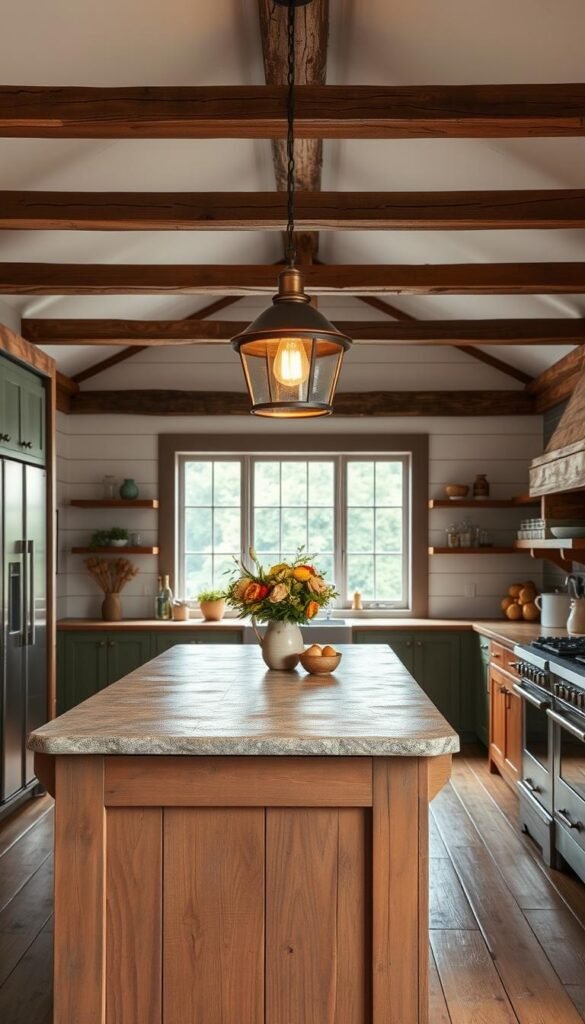
Muddy Tones That Warm Up the Space
Farrow & Ball’s Palm offers an earthy green alternative to predictable sage. Its olive undertones complement wood grains without overpowering them. For contrast, muted salmon (like Sherwin-Williams’ Cavern Clay) adds warmth to cooler spaces.
Pair deep tones with unlacquered brass hardware. The metal’s patina develops over time, mirroring the organic evolution of paint color. Test swatches at dawn and dusk—colors shift dramatically in changing light.
Pairing Colors with Natural Wood Accents
Balance bold walls with raw or whitewashed beams. A 1870s Scandinavian home paired Skywalker with pale oak cabinetry, letting the style feel anchored yet airy. For trim, semi-gloss highlights architectural details without competing with main walls.
| Color | Best Wood Pairing | Accent Tip |
|---|---|---|
| Skywalker (Backdrop) | White oak | Brass faucets |
| Palm (Farrow & Ball) | Reclaimed pine | Wrought iron shelves |
| Cavern Clay (SW) | Walnut | Terracotta tiles |
Pro tip: Paint a sample board and move it around the room. Shadows and sunlight alter perceptions—what looks taupe at noon may lean gray by evening.
5. Install a Classic Farmhouse Sink
The apron-front sink isn’t just practical—it’s the soul of a well-loved space. Its deep basin and exposed front elevate everyday tasks, blending durability with timeless appeal. Whether you’re rinsing garden veggies or stacking dishes after a feast, this centerpiece handles it all.
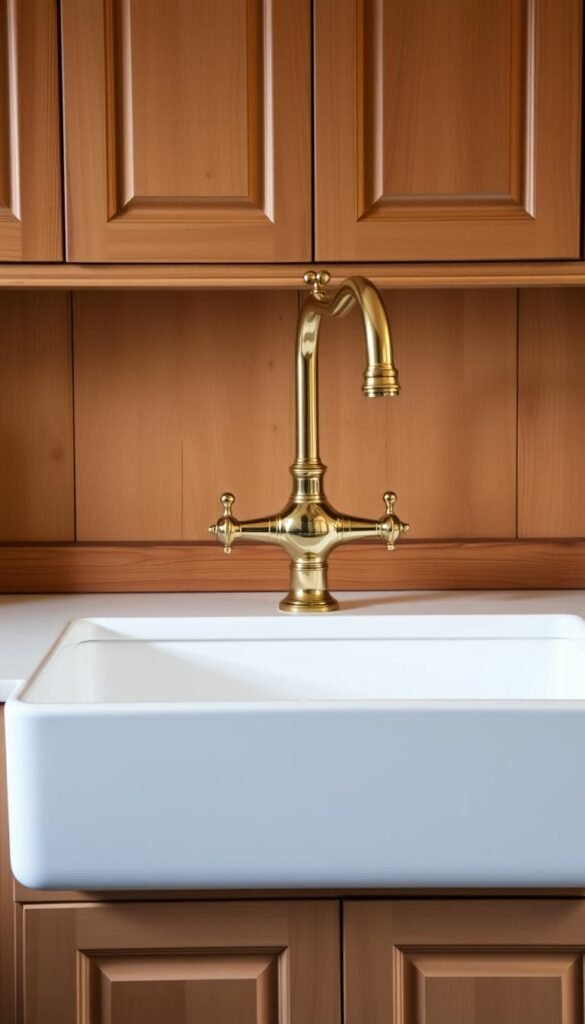
Apron-Front Sink Materials: Fireclay vs. Copper
Fireclay sinks, like Whitehaus’s 33″ model, withstand 1800°F firing for chip-resistant strength. Their glossy finish repels stains, ideal for busy kitchens. Copper offers natural antimicrobial properties—perfect for raw food prep—but requires regular polishing to maintain its shine.
- Fireclay pros: Scratch-resistant, low-maintenance, classic white design.
- Copper perks: Develops a lived-in patina, kills bacteria, warm metallic glow.
Choosing the Perfect Bridge Faucet
Pair your sink with a bridge faucet for ergonomic ease. Unlacquered brass models age beautifully, their warm tones deepening over time. Look for curved aprons to protect knees during long prep sessions.
| Feature | Fireclay Sink | Copper Sink |
|---|---|---|
| Maintenance | Wipe with soapy water | Polish monthly |
| Lifespan | 30+ years | 50+ years (with care) |
Installation tip: Reinforce cabinets with plywood for heavy fireclay models. For copper, add a protective undercoating to prevent condensation damage.
6. Frame Scenic Views with Bare Windows
Windows become art when left unadorned—framing nature like living paintings. In Christina Salway’s barn home, triple windows stretch floor-to-ceiling, capturing rolling pastures in a sunlit triptych. The absence of heavy drapes lets the design breathe, merging indoor and outdoor space seamlessly.
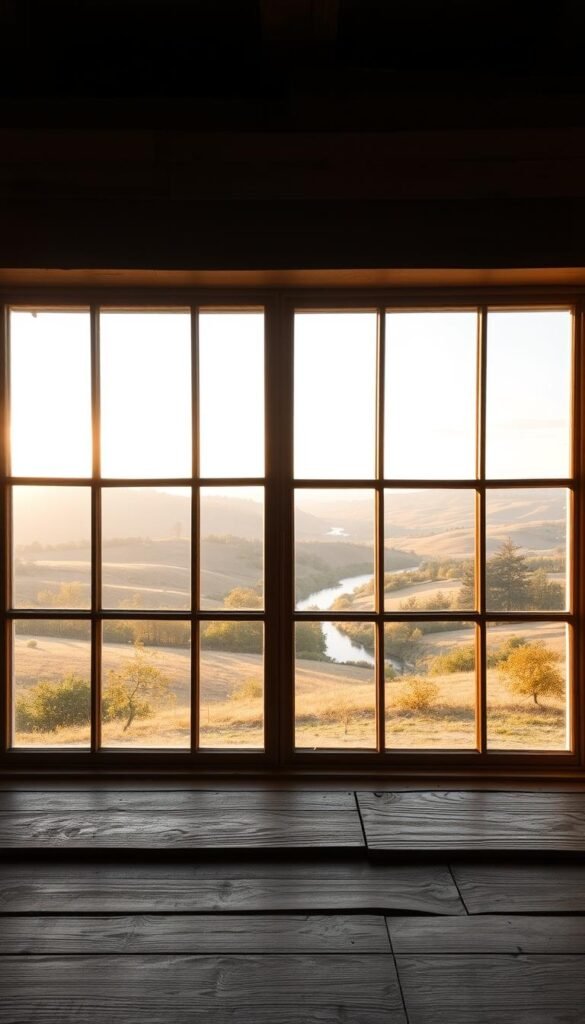
Minimalist Window Treatments for Light Control
Linen roller shades offer privacy without sacrificing light. Their gauzy texture diffuses sunbeams, softening harsh rays while preserving views. For sun-drenched rooms, UV-protective glazing shields fabrics and woods from fading—ideal for preserving heirloom furnishings.
- Sheer elegance: Linen filters light while maintaining openness.
- Practical upgrades: UV coatings extend the life of rugs and art.
- Hardware notes: Matte black brackets complement Shaker cabinetry.
Matching Trim to Cabinetry for Cohesion
Salway’s Farrow & Ball All White trim mirrors her cabinet frames at 2 1/4″ widths. This repetition creates rhythm, guiding the eye toward the windows’ country vistas. For wood pairings, maple trim aligns with oak floors, while walnut adds depth to pine walls.
| Trim Material | Best Paired With | Visual Effect |
|---|---|---|
| Maple | Oak floors | Subtle grain contrasts |
| Walnut | Pine walls | Rich tonal variation |
| MDF (painted) | White cabinets | Streamlined modernity |
Pro tip: Sample trim colors at different times. Morning light reveals undertones hidden by dusk’s shadows.
7. Make a Statement with Tile Backsplashes
Tile backsplashes transform blank walls into captivating focal points. They blend practicality with artistry—shielding surfaces from grease while adding design depth. Lauren Liess’ “Nostalgia” tile paired with a Hallman range proves how patterns can harmonize with collected-over-time charm.
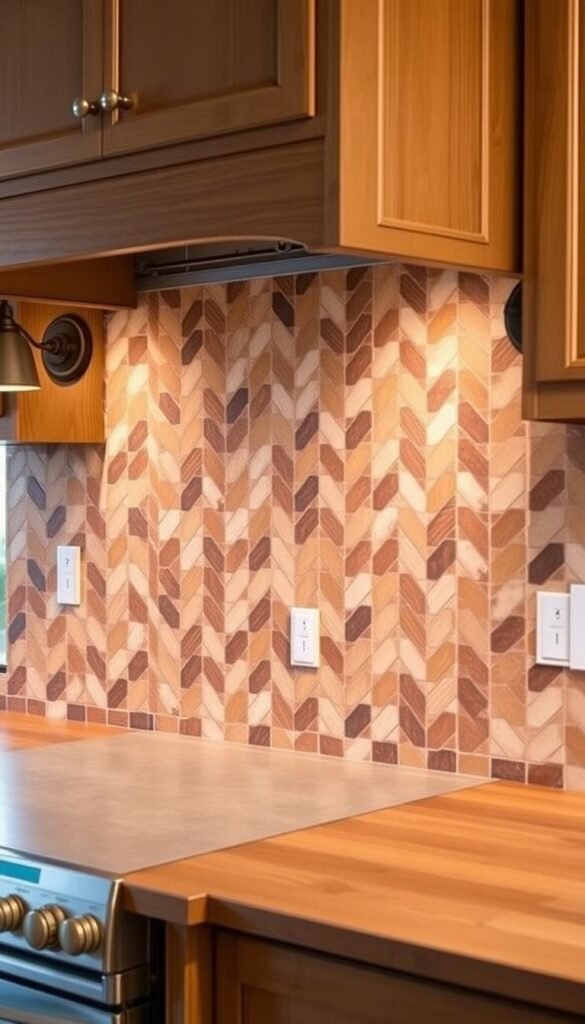
Bold Patterns vs. Subtle Textures
Graphic tiles, like Liess’ black-and-white motifs, command attention against neutral cabinetry. For softer contrast, tumbled marble subway layouts add organic variation. Their uneven edges and matte finish complement farmhouse style without overpowering.
Zellige tiles offer a middle ground—their hand-glazed surfaces catch light differently on each piece. Pair them with reclaimed oak floating shelves for balanced texture. Keep grout lines at 1/8″ to honor handmade imperfections.
- Maintenance tip: Seal textured tiles annually to prevent staining in crevices.
- Color echoing: Match cobalt tiles to enamelware for cohesive accents.
Mixing Tiles with Rustic Wood Shelves
Raw wood shelves ground intricate tile details. A Connecticut home paired herringbone cement tiles with walnut open shelving—the warm wood tones softened the geometric pattern. For smaller wall sections, vertical stack-bond layouts visually heighten the space.
| Tile Type | Best With | Maintenance Level |
|---|---|---|
| Zellige | Reclaimed oak | Medium (glaze varies) |
| Subway | Pine beams | Low (wipeable surface) |
| Hand-painted | Whitewashed brick | High (avoid abrasives) |
Pro tip: Test tile samples under both natural and artificial light. Moroccan fish-scale tiles may look peach at noon but blush-pink by lamplight.
8. Incorporate a Farmhouse Table
Gathering around a sturdy table transforms meals into cherished moments. Erica Harrison’s sanded walnut piece demonstrates how furniture becomes the heart of a space, its distressed surface inviting touch while standing up to daily use. This isn’t just a surface—it’s where memories are made.
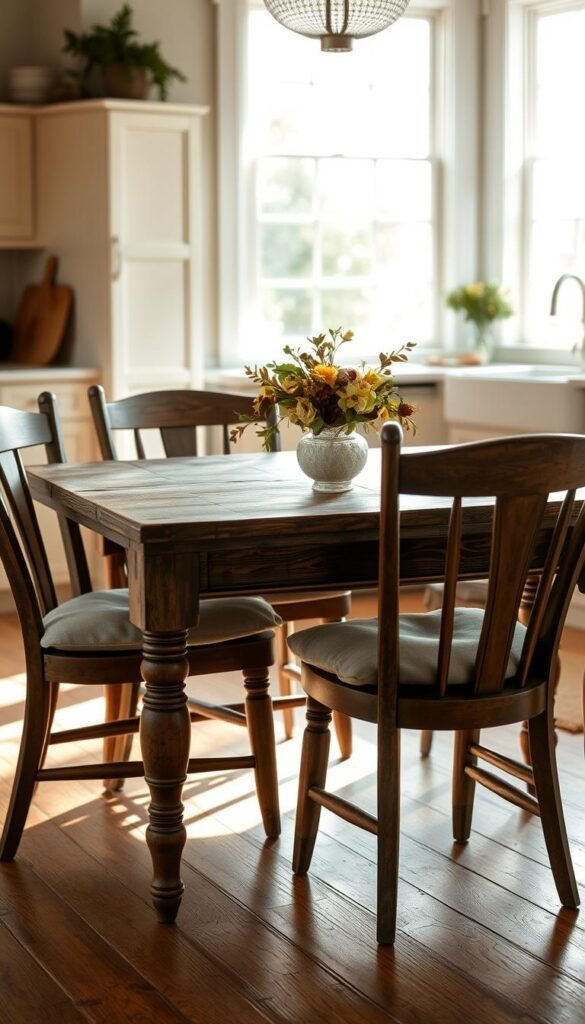
Sand-Distressed Finishes for Authenticity
Harrison’s multi-step process creates depth:
- Layer removal: 80-grit sandpaper exposes raw wood beneath stains
- Edge softening: Chains mimic decades of wear along aprons
- Sealing: Matte tung oil enhances grain without plastic-like shine
For a cohesive look, extend distressing to chair legs and shelf edges.
Pairing with Vintage Bentwood Chairs
Thonet-style chairs (circa 1920s) complement the table’s curves. Their steam-bent frames offer flexibility for all body types, while cane seats keep the aesthetic airy. Mix in two upholstered benches for variety—just maintain 30″ table height for ergonomic harmony.
| Table Style | Seating Capacity | Best For |
|---|---|---|
| Breadboard ends | 6-8 people | Narrow rooms |
| Trestle base | 10+ people | Large gatherings |
Vintage sourcing tip: Check flea markets for chairs with intact cane webbing—often cheaper than fully restored sets. Lightly sand and re-stain frames to match your table’s patina.
9. Display Collections on Open Shelving
Open shelves turn everyday dishes into artful arrangements. Unlike closed cabinets, they celebrate the beauty of functional things—think stacks of ironstone pitchers or hand-painted platters catching sunlight. Jean Hanff Korelitz’s Farrow & Ball Palm-backed built-ins prove how storage can elevate style.
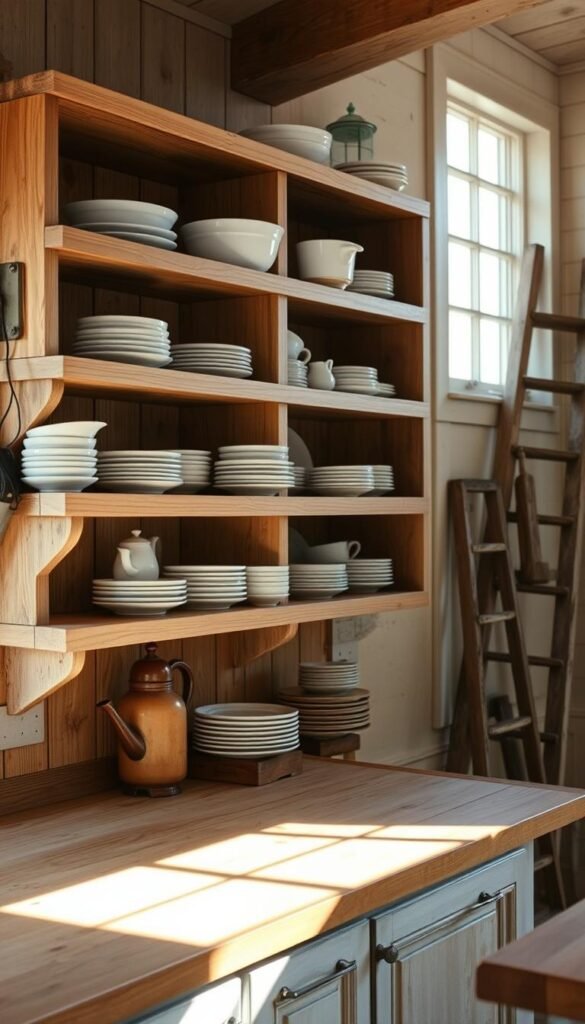
Styling Ironstone and Lustreware
Group odd-numbered pieces for visual harmony. A trio of creamware pitchers on a top shelf creates rhythm, while lustreware adds pops of peacock blue. Tiered shelves keep platters accessible yet artful.
- Depth matters: 12″ shelves fit dinner plates without crowding.
- Dust defense: Use frequently rotated items (like daily bowls) to minimize buildup.
- Color play: Pair white ironstone with metallic lustreware for contrast.
Balancing Function and Decoration
Reserve lower shelves for grab-and-go items—mugs, olive oil bottles—while upper tiers showcase heirlooms. A mix of open and closed storage (like a base cabinet) hides clutter without sacrificing charm.
| Shelf Level | Best For | Styling Tip |
|---|---|---|
| Top | Display-only (vintage tureens) | Use bookends as anchors |
| Middle | Daily dishes | Stack with textured liners |
| Bottom | Utensil crocks | Add woven baskets for bulkier items |
Pro tip: Rotate seasonal pieces—berry bowls in summer, soup tureens in fall—to keep the design fresh yet timeless.
10. Add Sunny Pantry Accents
Sunlight dancing on glass jars turns storage into a display of everyday beauty. A well-designed pantry balances function with charm—think amber containers catching golden hour rays or woven baskets corralling root vegetables. These accents transform a utilitarian space into a joyful retreat.

Glass Jars and Woven Baskets for Organization
Amber glass jars protect flour and sugar from light while adding warmth. For baskets, seagrass withstands moisture better than rattan—ideal for storing onions or potatoes. Designer Meta Coleman layered both in her pantry, pairing them with 45° shelf lighting to make jars sparkle.
- Durability: Seagrass resists fraying; rattan develops a patina over time.
- Lighting tip: LED strip lights at 3000K mimic natural sunlight.
- Styling: Group jars in odd numbers for visual harmony.
Cheerful Paint Choices for Small Spaces
Dark hues like Farrow & Ball’s Inchyra Blue add depth without shrinking the room. Coleman used it on lower cabinets, contrasting with upper shelves in All White. Eggshell sheen offers wipeability—perfect for splatter-prone areas.
| Paint Color | Best For | Sheen Tip |
|---|---|---|
| Inchyra Blue | Feature walls | Eggshell for durability |
| Hague Blue | Lower cabinets | Matte for rich texture |
Pro tip: Test colors at different times. *Inchyra Blue* shifts from stormy gray to navy under evening light.
11. Blend Industrial and Rustic Elements
The marriage of raw materials and sleek metals creates a space that feels both grounded and refined. Ken Pursley’s design demonstrates this balance—drafting stools surround a honed concrete island, their iron frames echoing pendant lights above. It’s a look that celebrates texture while keeping practicality front and center.
Metal Stools and Concrete Countertops
Polished concrete reflects light for a modern glow, while honed finishes hide smudges better in busy homes. Pursley prefers honed surfaces with subtle aggregate details—tiny stone flecks that add organic variation. For stools, 30″ heights align perfectly with standard 36″ counters.
- Maintenance: Seal concrete annually with penetrating formulas to resist stains.
- Patina pairing: Let iron stool legs develop rust tones that complement matte counters.
- Edge profiles: Waterfall edges modernize the look; eased edges soften it.
Vintage Pendant Lighting
Aged iron pendant lights add historical weight over islands. Their blackened finishes tie into stool frames, creating visual continuity. For larger spaces, cluster three at varying heights (30″-36″-42″) to define zones without crowding.
| Fixture Type | Best For | Bulb Tip |
|---|---|---|
| Caged industrial | High ceilings | Edison LEDs for warm glow |
| Schoolhouse glass | Task lighting | 3000K temperature |
This blend of industrial and organic accents proves that contrasts can coexist beautifully. The key lies in letting each material shine while finding harmony through shared tones and textures.
12. Use Beadboard for Cottage Charm
The gentle ridges of beadboard paneling whisper of coastal cottages and country homes. This farmhouse tradition dates to 19th-century America, where its overlapping grooves hid imperfect walls while adding texture. Today, it brings the same collected-over-time appeal to modern spaces.
Paneled Cabinets vs. Wall Applications
True Bead Wainscot Paneling from Home Depot works equally well on cabinets or wall surfaces. For cabinet doors, 4″ profiles keep the aesthetic light, while 6″ versions make bolder statements on pantry walls.
- Height illusion: Install vertically to draw eyes upward in low-ceilinged rooms
- Moisture resistance: Ideal for backsplashes behind sinks or ranges
- Historical accuracy: Original beadboard was 32″ tall—perfect for chair rails
Painting Beadboard for a Fresh Look
Oil-based enamel withstands decades of wear on high-touch areas. For a seamless charm, try color drenching—painting walls and trim the same hue. Benjamin Moore’s White Dove reflects light beautifully in grooves.
| Finish Type | Best For | Drying Time |
|---|---|---|
| Satin enamel | Kitchen cabinets | 8 hours |
| Matte latex | Accent walls | 4 hours |
Repair tip: Fill damaged grooves with wood filler, then sand with 220-grit paper. Wipe with tack cloth before repainting for smooth results.
13. Mix Wood Tones for Depth
The secret to a dynamic room lies in the interplay of wood grains. Ken Pursley’s signature design pairs oak floors with pine ceiling beams—a study in contrast that adds dimension. This approach celebrates natural variations while creating visual harmony.
Contrasting Floors and Ceiling Beams
Follow the three-tone rule for balance: floors (dark), cabinets (medium), beams (light). Wire-brushed oak adds texture underfoot, while hand-scraped pine overhead introduces organic irregularity. RH Restoration Hardware’s cerusing kits enhance grain patterns on oak surfaces.
- Depth trick: Match cabinet stains to existing trim for cohesion
- Texture guide: Wire-brushed for high-traffic areas, hand-scraped for ceilings
- Light reflection: Matte finishes on beams reduce glare
Choosing Reclaimed vs. Stained Wood
Reclaimed heart pine boasts warm amber hues that synthetic stains can’t replicate. For modern spaces, whitewashed oak offers a lighter alternative. Always test stains on sample boards—natural light reveals undertones hidden under artificial lighting.
| Material | Best Use | Maintenance |
|---|---|---|
| Reclaimed pine | Ceiling beams | Annual oil treatment |
| White oak | Floors | Biweekly sweeping |
| Cerused walnut | Furniture | Dust with microfiber |
Let the wood speak for itself. Variations in tone and texture become features, not flaws, when layered intentionally. For visual balance, repeat one wood element elsewhere—like oak cabinet pulls echoing floor tones.
14. Repurpose Vintage Finds Creatively
Vintage pieces tell stories—repurposing them blends history with function. Bambi Costanzo’s Facebook Marketplace dry sink transformation proves how imagination turns forgotten items into home highlights. These projects add personality while honoring the past.
DIY Dry Sink Transformations
Costanzo converted a 1920s dry sink into a coffee station using dowel rods as plate racks. The natural wood grooves hold mugs securely, while the enamel basin now stores coffee pods. This clever hack preserves the piece’s vintage charm while adapting it for modern use.
- Material prep: Lightly sand surfaces before chalk painting to ensure adhesion
- Rod spacing: Place dowels 1.5″ apart for standard dishware
- Finish options: Dark wax accentuates carvings; whitewash brightens dark wood
Skirted Cabinets with Fabric Panels
Give basic cabinets character with removable fabric skirts. Linen withstands daily wear better than burlap, though both develop a lovely patina. For a farmhouse touch, add scalloped edges using Butterick’s B6224 sewing pattern.
| Closure Type | Installation | Best For |
|---|---|---|
| Magnetic strips | Adhesive backing | Frequent access areas |
| Velcro | Sewn to fabric | Lightweight materials |
Distress metal hardware with chalk paint for instant age:
- Clean knobs with degreaser
- Apply base coat, let dry
- Rub edges with sandpaper to reveal underlying metal
15. Layer Textures with Natural Materials
Texture transforms a room from flat to fascinating—layering natural materials creates depth underfoot and overhead. From chunky jute rugs to hand-hewn beams, these elements collaborate to build warmth that synthetic materials can’t replicate. Designer Leanne Ford’s pegboard-and-shiplap combo demonstrates how intentional contrasts craft cohesive character.
Jute Rugs and Wicker Chairs
Chunky knit jute rugs add sculptural dimension, while flat-weave versions suit high-traffic areas. For wicker chairs, beeswax conditioning restores flexibility to dried fibers. Apply it with a soft cloth, working along the weave’s natural pattern.
- Durability test: Rub rugs with a damp cloth—quality jute won’t shed.
- Color options: Natural hues age gracefully; dyed versions offer bold contrast.
- Chair care: Reapply beeswax annually to prevent cracking in arid climates.
Wooden Ceiling Beams and Shiplap Walls
Faux beams crafted from lightweight polyurethane mimic reclaimed wood without structural strain. Install them with 1×8 shiplap panels spaced with nickel gaps for shadow lines that enhance texture. This farmhouse tradition works equally well in modern spaces when paired with matte finishes.
| Material | Best For | Installation Tip |
|---|---|---|
| Chunky jute rug | Low-traffic seating areas | Use rug pad to prevent slippage |
| Flat-weave jute | Entryways | Seal with fabric protector |
| Faux wood beams | Rental homes | Mount with construction adhesive |
For a relaxed vibe, extend textural accents vertically—rough-hewn beams overhead, ribbed shiplap at eye level, and nubby rugs underfoot. This layering technique guides the eye while maintaining harmony.
Conclusion
The best rooms evolve over time, layering memories with purpose. A farmhouse style thrives on this balance—natural materials like wood and stone age gracefully, while vintage finds add soul. Start small: fresh paint and open shelving can redefine a space without overwhelming changes.
Quality matters. Hardwoods and metals last decades, their patina deepening with use. Let your design reflect your story—a mix of heirlooms and modern touches creates warmth that feels intentional.
Above all, remember: a home isn’t built in a day. It’s a collection of moments, each detail adding to the narrative.
